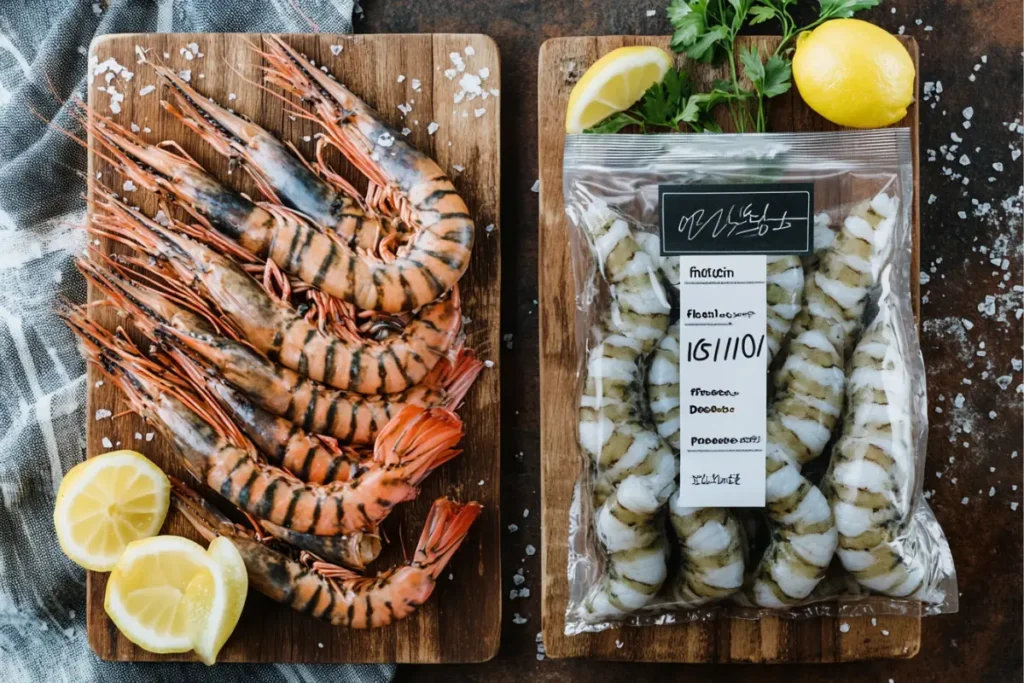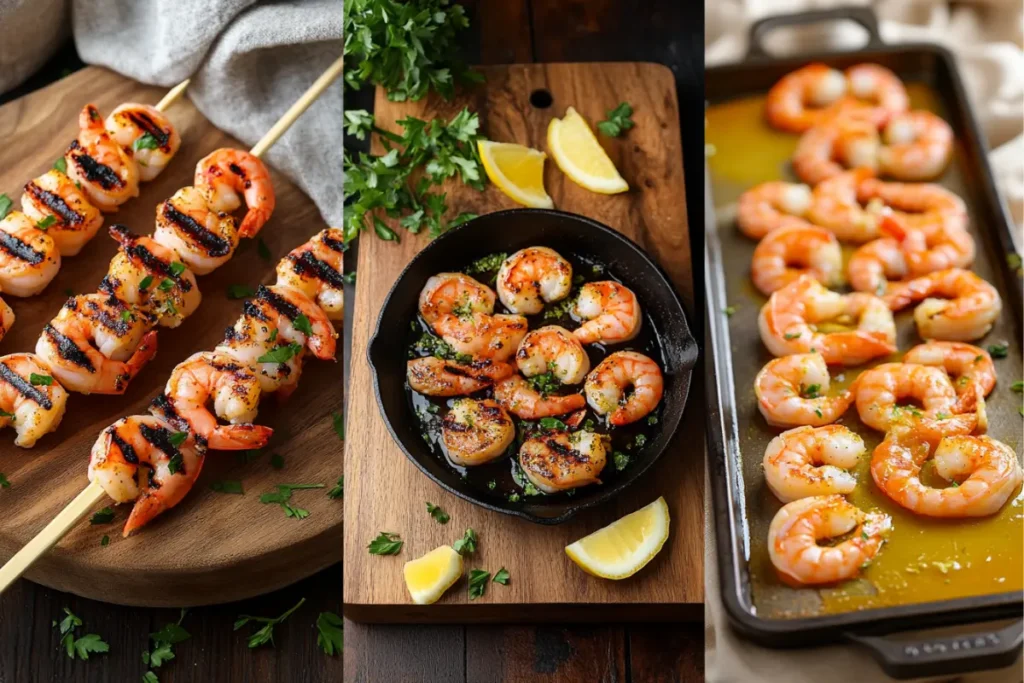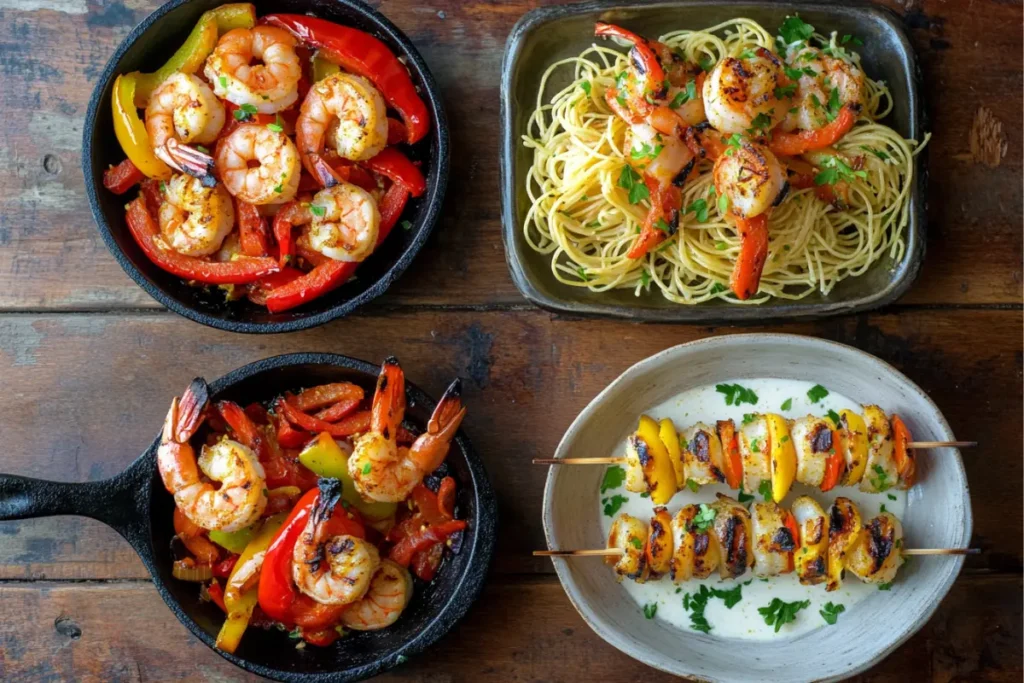Imagine a seafood delight that turns heads with its bold size and captivating stripes. Tiger shrimp (sometimes called tiger prawns) are prized around the globe for their slightly sweet flavor, firm texture, and incredible versatility.
In this comprehensive guide, you’ll learn how to select the freshest tiger shrimp, prepare them perfectly, and explore easy yet mouthwatering recipes—from spicy Cajun boils to elegant Mediterranean grills. Whether you’re new to cooking shrimp or a seasoned pro, discover why tiger shrimp truly are the star of the seafood world!
Table of Contents
What Are Tiger Shrimp?
Defining Tiger Shrimp
Tiger shrimp, known scientifically as Penaeus monodon, are one of the largest shrimp. They are easy to recognize because of their black and orange stripes. These shrimp come in different sizes, from regular to jumbo, and are popular for their striking look.
Tiger shrimp are different from other shrimp, like Black Tiger Prawns, because of their sweet flavor and firm texture. They also hold their shape well when cooked. These features make them a favorite for many seafood dishes.
What is special about tiger prawns? Tiger prawns are loved for their large size, mild sweetness, and ability to soak up marinades. They are perfect for grilling, frying, or baking. Whether used in simple meals or fancy recipes, tiger prawns always stand out.
Origins, Habitat, and Cultural Significance
Tiger shrimp live in warm waters, especially in the Indo-Pacific region. They are found in areas like India, Southeast Asia, and Australia. They can be caught in the wild or farmed in controlled environments. Farming has made them more available, but it can also impact the environment.
Choosing tiger shrimp from sustainable sources is important. Look for labels like the Marine Stewardship Council (MSC) to ensure they are responsibly sourced. This helps protect the oceans while enjoying these delicious shrimp.
Tiger shrimp are loved in many cuisines around the world. They are used in Vietnamese stir-fries, Cajun seafood boils, and grilled Mediterranean dishes. Their flavor and texture make them perfect for everyday meals or special occasions.
Buying and Selecting Tiger Shrimp

Fresh vs. Frozen
When you buy tiger shrimp, you can choose between fresh and frozen options. Fresh shrimp work best if you live near the coast and can find them at a local market. You can identify fresh shrimp by their firm texture, shiny shells, and mild ocean smell.
Frozen shrimp stay flavorful because producers freeze them soon after catching. If you pick frozen shrimp, thaw them properly to maintain their taste and texture. Always check for clean shells, firm meat, and no strong odors to ensure quality.
Shell-On vs. Peeled and Deveined
Cooking shell-on shrimp adds more flavor to your dish because the shell helps protect the meat and keeps it moist. If you want a rich-tasting dish, leave the shells on during cooking.
Peeled and deveined shrimp save you time and make meal prep faster. You can cook them right away, but they may lose some of their natural flavor. Decide based on your recipe and cooking style.
Should I peel tiger shrimp before cooking? Keep the shells on if you’re grilling or frying to boost flavor. Peel them first if you’re using them in pasta dishes or stir-fries for easier eating.
Do I need to devein tiger prawns? Devein tiger prawns for a cleaner look and to remove grit. For large shrimp, deveining makes them more enjoyable to eat.
Size Grading
Size labels like U10, U12, or 16/20 show how many shrimp come in a pound. For example, U10 shrimp have fewer than 10 shrimp per pound, making them larger and meatier. Smaller sizes, like 16/20, mean there are 16 to 20 shrimp per pound.
Larger shrimp work well for grilling or roasting because of their size and texture. Choose smaller shrimp for soups, stir-fries, or dishes where they cook quickly. Picking the right size helps your recipe turn out just right.
Pairing Tiger Shrimp With Great Side Dishes
If you’re looking for side dishes to complement your fresh tiger shrimp, check out our What to Serve with Crab Legs guide. Many of those suggestions work just as well for shrimp, enhancing both flavor and presentation
Cleaning and Preparing Tiger Shrimp
Thawing Frozen Shrimp
The first step in preparing frozen tiger shrimp is proper thawing. The best method is to place the shrimp in the refrigerator overnight. This method keeps them at a safe temperature while they thaw slowly.
If you need them thawed faster, use cold water. Put the shrimp in a sealed bag and submerge it in a bowl of cold water. Change the water every 30 minutes until the shrimp are soft. Avoid thawing shrimp in the microwave, as it can make them rubbery and unevenly cooked.
Deveining Tiger Shrimp
Deveining shrimp is important for both appearance and texture. The “vein” is the digestive tract, which can contain grit. While it won’t harm you if left in, deveining improves the shrimp’s presentation and taste.
How to devein shrimp:
- Start by removing the shell, if needed, leaving the tail on for presentation.
- Make a shallow cut along the back of the shrimp using a paring knife.
- Lift the vein gently with the tip of the knife or use a toothpick to pull it out.
- Rinse the shrimp under cold water to clean it thoroughly.
What happens if you don’t devein prawns? If you skip deveining, the shrimp will still be safe to eat, but the texture may feel gritty, and the appearance won’t be as clean. Deveining is highly recommended for larger tiger shrimp.
How to clean shrimp poop? The “poop” line is the same as the vein. Follow the deveining steps to remove it for a cleaner and more appealing dish.
Rinsing and Pre-Cooking Treatments
Always rinse tiger shrimp under cold water to remove any dirt or residue. This step ensures the shrimp are clean and ready for cooking. After rinsing, pat them dry with a paper towel.
For juicier shrimp, you can brine them before cooking. Mix 2 cups of cold water with 1 tablespoon of salt and 1 teaspoon of baking soda. Soak the shrimp for 15–30 minutes. This method enhances their texture and helps retain moisture during cooking.
Why do people add baking soda to shrimp? Baking soda improves the firmness and juiciness of the shrimp. It helps the meat stay plump and tender, especially during high-heat cooking methods like grilling or sautéing.
If you prefer extra flavor, marinate the shrimp before cooking. Simple marinades with garlic, lemon juice, and olive oil work well, or you can try soy sauce and ginger for an Asian twist. Marinate for 20–30 minutes for the best results.
Cooking Tiger Shrimp: Methods and Recipes

Grilling Tiger Shrimp
Grilling brings out the best flavors in tiger shrimp. Start by preheating the grill to medium-high heat. Brush the shrimp with olive oil and season with salt, pepper, and your favorite spices. Use skewers to make flipping easier and to prevent the shrimp from falling through the grates.
Place the shrimp on the grill and cook for 2–3 minutes per side, or until the flesh turns pink and opaque. Avoid overcooking by removing the shrimp as soon as they are done. To prevent sticking, always oil the grill grates before cooking.
Love other grilled seafood? Take a look at our recipe for Grilled Snow Crab Legs, which pairs excellently with seasoned tiger shrimp.
Pan-Searing Tiger Shrimp
Pan-searing is perfect for achieving a golden crust on your shrimp. Heat a non-stick or cast-iron skillet over medium-high heat and add a tablespoon of oil or butter. Once the pan is hot, place the shrimp in a single layer, making sure not to overcrowd the pan.
Cook the shrimp for 1–2 minutes per side until they are pink and slightly caramelized. For extra flavor, add minced garlic or fresh herbs during the last 30 seconds of cooking. Serve immediately for the best texture and taste.
Broiling Tiger Shrimp
Broiling is a quick and easy method for cooking tiger shrimp. Preheat your broiler and place the shrimp on a baking sheet lined with foil. Brush them with a marinade or seasoned butter for added flavor.
Position the baking sheet 4–6 inches from the heat source and broil for 2–3 minutes per side. Keep a close eye on the shrimp to prevent burning. Broiling gives the shrimp crispy edges and a smoky finish that pairs well with citrus flavors.
Other Methods
Stir-frying is a fast way to cook tiger shrimp. Heat a wok or large skillet over high heat, add oil, and toss the shrimp with vegetables and sauces for a complete meal in minutes.
Boiling is ideal for shrimp cocktails or seafood boils. Add the shrimp to a pot of boiling water with lemon slices and spices, then cook for 2–3 minutes until pink. For baking, place the shrimp on a tray with seasonings or marinades, and bake at 400°F for 8–10 minutes.
Tiger Shrimp Recipes

Spicy Cajun Tiger Prawns
Ingredients:
- 1 lb tiger shrimp, peeled and deveined
- 2 tablespoons Cajun seasoning
- 2 tablespoons olive oil
- 2 cloves garlic, minced
- 1 tablespoon lemon juice
- Fresh parsley, chopped (for garnish)
How to Make It:
- To begin with, season the shrimp generously with Cajun seasoning.
- Additionally, heat olive oil in a pan over medium heat.
- Meanwhile, sauté the garlic for about 30 seconds until it becomes fragrant.
- Afterward, add the shrimp to the pan and cook for 2–3 minutes on each side until pink.
- Following this, squeeze lemon juice over the shrimp and toss gently.
- Lastly, garnish with parsley and serve with rice or crusty bread.
Craving a smoky Cajun flavor? Try our spin on blackened shrimp in these Blackened Shrimp Bowls Recipes for an extra spicy kick.
Garlic Butter Tiger Shrimp
Ingredients:
- 1 lb tiger shrimp, peeled and deveined
- 3 tablespoons unsalted butter
- 3 cloves garlic, minced
- 1 tablespoon lemon juice
- Fresh parsley, chopped (for garnish)
- Optional: cooked pasta or bread for serving
How to Make It:
- Initially, melt the butter in a large pan over medium heat.
- Moreover, add the garlic and sauté for about 1 minute until fragrant.
- After that, place the shrimp in the pan and cook for 2 minutes on each side until pink.
- Then stir in the lemon juice and sprinkle with parsley.
- Finally, serve with pasta or bread for a satisfying meal.
Grilled Lemon Herb Tiger Shrimp
Ingredients:
- 1 lb tiger shrimp, peeled and deveined
- 3 tablespoons olive oil
- 2 tablespoons lemon juice
- 2 cloves garlic, minced
- 1 teaspoon dried thyme
- 1 teaspoon dried rosemary
How to Make It:
- To start, mix olive oil, lemon juice, garlic, thyme, and rosemary in a bowl to create a marinade.
- In the meantime, marinate the shrimp for 15–20 minutes to absorb the flavors.
- Furthermore, preheat the grill to medium heat and lightly oil the grates.
- After marinating, place the shrimp on the grill and cook for 2–3 minutes per side.
- Finally, serve the shrimp with grilled vegetables or a light salad for a summer meal.
Tiger Shrimp Scampi
Ingredients:
- 1 lb tiger shrimp, peeled and deveined
- 3 tablespoons unsalted butter
- 3 cloves garlic, minced
- ½ cup white wine
- 1 tablespoon lemon juice
- Fresh parsley, chopped (for garnish)
- Optional: cooked pasta or rice for serving
How to Make It:
- Initially, heat butter in a large pan over medium heat.
- Furthermore, sauté the garlic for about 1 minute until it becomes fragrant.
- After that, add the shrimp and cook for 2 minutes per side until pink.
- Subsequently, pour in the white wine and lemon juice, and let it simmer for 1–2 minutes.
- Lastly, garnish with parsley and serve over pasta or rice for a classic dish.
Tip: For a richer twist, try drizzling your shrimp with a homemade sauce. Learn How to Make Cajun Alfredo Sauce and give your scampi an extra kick!
Tips for Perfect Tiger Shrimp
Cooking tiger shrimp to perfection is all about timing. Look for doneness cues like a pink color, opaque flesh, and a gently curled shape. Overcooking shrimp can make them tough, so remove them from the heat as soon as they are fully cooked.
To prevent toughness, cook the shrimp quickly over medium to high heat. Shrimp only need 2–3 minutes per side, depending on their size. Using a timer can help you avoid overcooking them.
Tiger shrimp pair well with many flavors. Citrus-based sauces, like lemon butter, bring out their sweetness, while spicy seasonings, such as Cajun or chili, add a bold kick. Serve them with rice, pasta, or fresh vegetables to create a balanced meal.
Tiger Shrimp: Health and Nutrition
Tiger shrimp are an excellent source of lean protein and are naturally low in fat. A single serving can provide about 20 grams of protein, making them a great choice for building and maintaining muscle. They are also rich in omega-3 fatty acids, which support heart health.
In addition, tiger shrimp contain vitamin B12, which helps boost energy and maintain healthy red blood cells. However, it’s important to consider their cholesterol and sodium content, especially for people monitoring their intake. Moderation is key for enjoying shrimp as part of a balanced diet.
What are the disadvantages of prawns? While prawns are nutritious, they do contain cholesterol and sodium. For individuals with dietary restrictions, it’s best to limit portions and pair them with low-sodium ingredients for a healthier meal.
Frequently Asked Questions
Does tiger shrimp taste good?
Yes, tiger shrimp taste amazing! Their flavor is sweet, and the texture is firm and succulent. Because of this, they are a popular choice in many seafood recipes. Whether you grill, sauté, or bake them, tiger shrimp always deliver a delicious, satisfying taste.
What is the orange stuff in tiger prawns?
The orange stuff in tiger prawns is roe, which are eggs. Many people consider them a delicacy because of their rich, slightly briny flavor. In fact, the roe is completely edible and can add a unique taste to your dish.
Are black spots on shrimp safe to eat?
Black spots on shrimp are caused by oxidation, which happens as the shrimp age. However, these spots are not harmful, so you can eat the shrimp safely. That said, if the shrimp have a strong smell or feel slimy, it’s better to choose fresher ones instead.
What is the blue vein on the underside of shrimp?
The blue vein on the underside of shrimp is part of their circulatory system. It is safe to eat, but some people choose to remove it for better presentation. If you want your shrimp to look clean and neat, you can gently pull out the vein before cooking.
Can dogs eat shrimp?
Yes, dogs can eat shrimp as a treat. However, you should always serve it plain and cooked without seasoning or oils. Too much shrimp isn’t good for dogs, so give it in moderation. Additionally, avoid giving your dog shrimp shells as they can be hard to digest.
How to remove smell from prawns before cooking?
To remove the smell from prawns, rinse them under cold water first. Next, soak them in a mixture of vinegar, lemon juice, or milk for a few minutes. After soaking, rinse them again to ensure no odor remains. This simple method makes the prawns fresh and ready for cooking.
Conclusion
In conclusion, tiger shrimp are one of the most versatile and delicious seafood options available. Their sweet flavor and firm texture make them perfect for many recipes. Whether you’re grilling, sautéing, or baking, tiger shrimp never disappoint.
Throughout this guide, we’ve shared tips, cooking methods, and recipes to help you create amazing dishes. You can try spicy Cajun prawns, garlic butter shrimp, or a light lemon herb dish. No matter which recipe you choose, tiger shrimp bring exciting flavors to your table.
Have other seafood favorites? Don’t miss out on learning What to Serve with Crab Legs or exploring our Tiger Shrimp Recipes and Cooking Tips for even more delicious inspiration!
Finally, we’d love to hear from you! Do you have a favorite tiger shrimp recipe or tip? Share your ideas in the comments below and inspire others to enjoy cooking with this incredible seafood.

